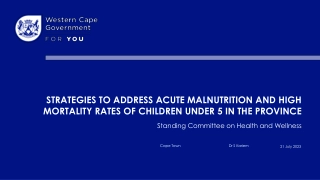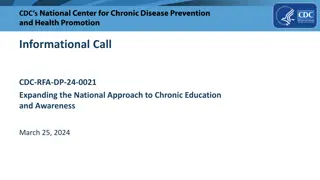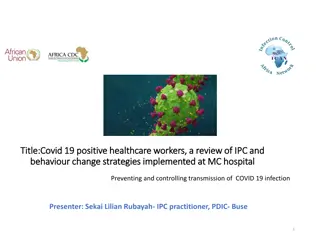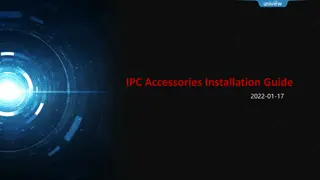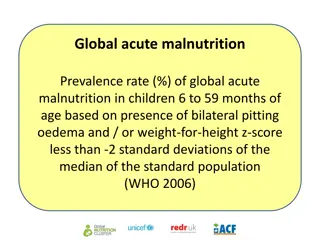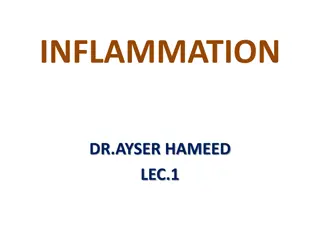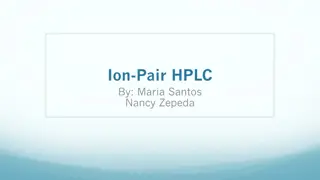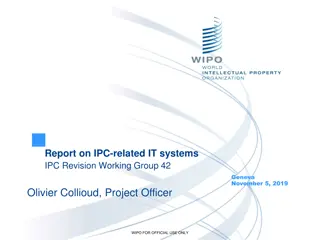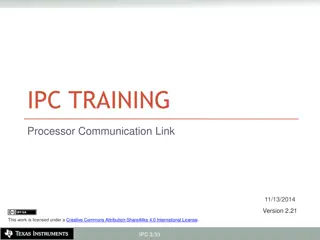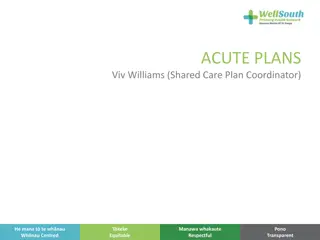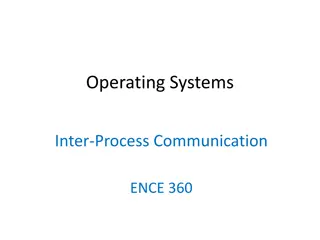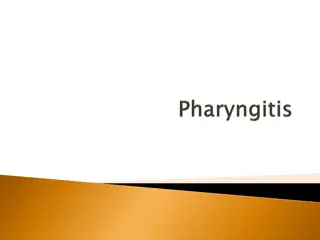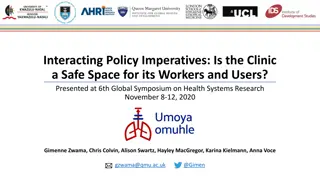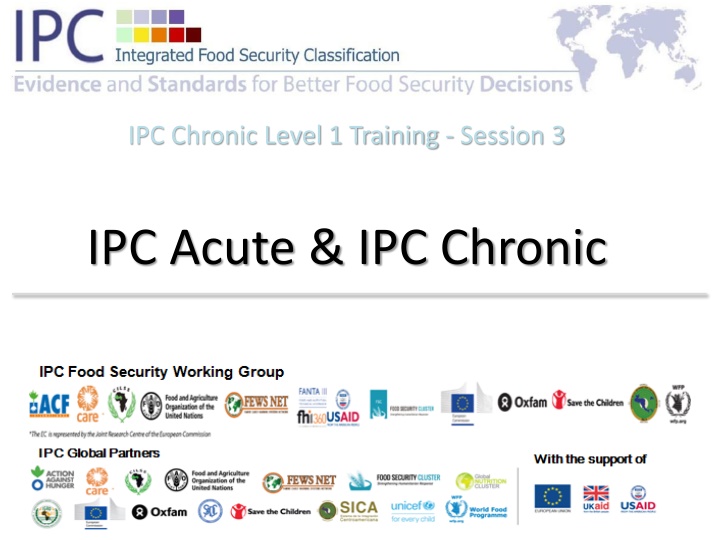
Acute and Chronic Food Insecurity for IPC Classification
Explore the distinction between acute and chronic food insecurity, their significance in IPC classification, and the essential information each approach offers for decision-making. Learn why IPC incorporates both classifications, their definitions, and how they inform short-term and long-term strategic objectives. Unveil the nuances of acute and chronic food insecurity analysis for IPC and grasp the critical differences that necessitate tailored responses to each.
Download Presentation

Please find below an Image/Link to download the presentation.
The content on the website is provided AS IS for your information and personal use only. It may not be sold, licensed, or shared on other websites without obtaining consent from the author. If you encounter any issues during the download, it is possible that the publisher has removed the file from their server.
You are allowed to download the files provided on this website for personal or commercial use, subject to the condition that they are used lawfully. All files are the property of their respective owners.
The content on the website is provided AS IS for your information and personal use only. It may not be sold, licensed, or shared on other websites without obtaining consent from the author.
E N D
Presentation Transcript
IPC Chronic Level 1 Training - Session 3 IPC Acute & IPC Chronic IPC Food Security Working Group IPC Global Partners With the support of
Learning Objectives At the end of this session you will be able to: Explain the definition of Acute and Chronic Food Insecurity for IPC Describe the key differences and complementarity between the two classification approaches List the different types of information that each approach provides to decision makers 2
Why IPC includes classification of Acute & Why IPC includes classification of Acute & Chronic food insecurity? Chronic food insecurity? Acute and Chronic food insecurity are different and thus require different but well coordinated and linked responses IPC recognized the need to differentiate the 2 conditions in 2008. IPC v1.1 (2008) focused on the classification of acute food insecurity useful to guide humanitarian action Users highlighted that IPC-Acute did not provide critical information to guide decision making with medium and long-term objectives IPC Chronic included in IPC v2.0 IPC v2 (2012): Chronic protocols added as a prototype IPC v2 Addendums (2014 and 2016): Chronic protocols finalized and an Addendum to the IPC Technical Manual prepared New, integrated IPC Manual launched in April 2019 incorporating IPC Acute, IPC Chronic and IPC Acute Malnutrition
Definition of Acute and Chronic Food Insecurity Analysis for IPC Classification All food insecurity found at a specific point in time of a severity that threatens lives and/or livelihoods regardless of the causes, context or duration. To inform short term strategic objectives (e.g. food/cash aid, asset redistribution, basic needs support, saving lives) ACUTE FOOD INSECURITY Persistent food insecurity due to structural causes. To inform medium and long term strategic objectives (e.g. structural development, agricultural and rural development policies, and strengthening livelihood strategies and adaptive capacity) CHRONIC FOOD INSECURITY
Deconstructing Definition of Acute and Chronic Food Insecurity for IPC Classification Acute Food Insecurity all food insecurity of a severity that threatens lives and/or livelihoods usually more linked to food quantity regardless of the causes, context or duration more severe forms of acute food insecurity are usually driven by external shocks/events those in the most severe phases (Phases 4 or 5), are not expected to remain there long without getting worse (and potentially dying) or getting better. Chronic food insecurity that which persists of any size in terms of food quality and quantity due to structural causes persistence is determined based on analysis of conditions under non-exceptional circumstances those in the most severe levels (Levels 3 or 4) can remain there for a long time 5
What are the differences and complementarities What are the differences and complementarities between IPC between IPC- -Acute & IPC Acute & IPC- -Chronic? Chronic? Factor Chronic Acute To inform actions that focus on the medium and long-term improvement of the quality and quantity of food consumption for an active and healthy life. To inform actions that focus on short- term efforts to prevent, mitigate, and/or decrease severe food insecuritythat threatens lives or livelihoods. Relevance Food insecurity found in a specified area at a specific point in time and of a severity that threatens lives and/or livelihoods regardless of the causes, context or duration. 5 Severity Phases: Food insecurity that persists over time and is mainly caused by structural issues. Definition 4 Severity Levels: (1) Minimal/None (2) Stressed (3) Crisis (4) Emergency (5) Catastrophe/Famine (1) No Chronic Food Insecurity (CFI) (2) Mild CFI (3) Moderate CFI (4) Severe CFI Classification Scale Low: changes are slow and happen gradually High: dynamic, Phases of acute food insecurity can and often do change quickly Susceptibility to change Validity period Long: 3-5 years in the absence of major structural changes Short: days /weeks/ months
What are the differences and complementarities What are the differences and complementarities between IPC between IPC- -Acute & IPC Acute & IPC- -Chronic? Chronic? Factor Chronic Acute Persistence of food insecurity is determined based on analysis of conditions under non- exceptional circumstances. Quick-changing indicators are referenced for non-exceptional circumstances. Snap-shots of the severity of food insecurity for current or projected periods. Analysis Approach Quick-changing indicators are analyzed as snap shots. Indicators Slow-changing indicators, such as stunting, are included in the analysis even when captured during exceptional conditions. Focus on identifying gaps of any size in the quality and quantity of food consumption Slow-changingindicators are not included in the Reference Table and therefore are not directly used for the classification. Focus on identifying significant gaps in the quantity of food consumed that can endanger livelihoods or lives. Focus on changes in livelihood strategies and assets as a result of an inability to secure sufficient quantities of food or essential non-food items Focus on food consumption Focus on analysis of livelihood strategies, assets, and policies, institutions and processes that exist under non-exceptional conditions. Livelihood Lens IPC Compatible analysis not an option; all IPC Chronic Analysis expected to follow all IPC functions, and protocols included in the IPC Chronic Addendum of the Manual Possible to conduct IPC Compatible analysis by following all IPC functions and protocols except for the protocol on consensus building IPC Compatible
Relationship between IPC Acute and Chronic Relationship between IPC Acute and Chronic Acute & Chronic are not mutually exclusive - Bi-directional relationship Necessary to examine the nature of, and linkages between them to respond strategically Severity of Food Insecurity High Low Chronic Acute Chronic Acute Chronic Acute Chronic Acute Interventions Appropriate Types of Short-term objectives (relief) Short-term objectives (relief) linked to Long-term objectives (development) Lower priority areas long-term objectives (development)
How IPC Acute and Chronic Work? IPC Acute & IPC Chronic have same 4 Functions: Function 1: Build Technical Consensus Function 2: Classify Severity & Identify Key Drivers - Acute Food Insecurity - Chronic Food Insecurity Function 3: Communicate for Action - Acute Food Insecurity - Chronic Food Insecurity Function 4: Quality Assurance 9
Acute and Chronic Food Insecurity Exercise 3.1 Task: In groups of three... 1. Fill in the missing parts of the table identifying the differences between acute and chronic 2. Be ready to present your discussions to the group 10
Wrap-up Do you feel you can .? Explain the definition of Acute and Chronic Food Insecurity for IPC Describe the key differences and complementarity between the two classification pproaches List the different types of information that each approach gives to decision makers 11


